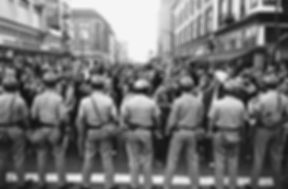
1970 — Convocation in UC Berkeley's Greek Theatre to protest expansion of Vietnam War into Cambodia
The history behind the US invasion of Cambodia
On May 6, 1970, a crowd of over 10,000 attended a rally in UC's Greek Theater to hear speakers voicing their reaction to the military invasion of Cambodia. The U.S. government's justification for the invasion, conducted by the U.S. military and the South Vietnamese army, was the use by the Viet Cong and the North Vietnamese Army of trails and camps along the eastern border of Cambodia. These routes were used by the communist forces to establish bases of military operations, maintain protected supply routes and provide a degree of safety for troop movements. Cambodian resistance to this practice was weak, and the communist forces were able to move unhindered from north to south for a period of years.
The Cambodian campaign (also known as the Cambodian incursion and the Cambodian invasion) was a brief series of military operations conducted as an extension of the Vietnam War and the ongoing Cambodian Civil War. Thirteen major operations were conducted between the beginning of May and the end of June..
The objective of the Cambodian invasion was the defeat of the approximately 40,000 troops of the People's Army of Vietnam (PAVN) and the Viet Cong (VC) in the eastern border regions of Cambodia. With the US shifting toward a policy of "Vietnamization" of the war and the withdrawal of US troops, the US sought to shore up the South Vietnamese government by eliminating the cross-border threat.
A US-inspired change in the Cambodian government allowed an opportunity to destroy the enemy bases in 1970, after a neutral Prince Norodom Sihanouk was deposed and replaced by pro-U.S. General Lon Nol. Underestimating the capabilities of the enemy, allied military operations failed to eliminate many PAVN/VC troops or to capture their elusive headquarters, The capture of some PAVN /VC military equipment, however, gave the US the opportunity to claim the operation as a "success."
The rise and fall of the Khmer Rouge
In 1975, the Lon Nol regime was overthrown by the Khmer Rouge, a long-standing communist army and political grouping involved in the Cambodian civil war. Initially, the North Vietnamese supported the Khmer Rouge, which considered itself part of the communist world. The Khmer Rouge, with the support of China (which was undergoing the atrocities of the "Cultural Revolution,") instituted a misguided, forced agricultural "revolution." Resistance to the forced mass relocation to what amounted to agricultural concentration camps led to a cruel campaign to punish non-compliance.
Genocide and North Vietnam to the rescue
Approximately one million Cambodians were executed by the Khmer Rouge, and over 500,000 died of starvation and disease between 1975 and 1979. Vietnam invaded Cambodia in 1979 and overthrew the Khmer Rouge government and defeated its army. The Vietnamese engineered the formation of a new, pro-communist government of the "Democratic Republic of Kampuchea."
Cambodia's rejection of North Vietnamese influence
In 1989 North Vietnamese troops withdrew from Kampuchea, and the country, now Cambodia again, underwent a transitional period with a UN peacekeeping force attempting to keep down violence, as a number of forces vied for political control. After the fall of most communist governments around the world in 1991, Cambodia reverted to a "constitutional monarchy," with a nominal king and democratic form of government, retaining its former prime minister, Hun Sen, who has governed, without any significant opposition, for over 35 years.
Part of the crowd of over 10,000. Asian American students had organized during the Third World Liberation Front campaign of 1969, and they were a visible presence at the Convocation
This speaker was identified by the handwritten I.D. on his military-styled jacket as "Shabazz Shabazz" Shabazz is a Muslim name. This striking individual may have been a Vietnam Veteran.
Speaker Marlene Dixon, controversial U. of Chicago sociology professor fired in 1969 for her radical views. In 1974 Ms. Dixon founded and became the leader of a self-declared revolutionary group, the Democratic Workers Party (DWP). The DWP became an internally violent, small cult built around Dixon, which imploded and dissolved in 1988.
Mike Tigar, human rights attorney, B.A. UC Berkeley and law degree from UCB's Boalt Hall. As an undergraduate, he was elected to the Associated Students of the University of California (ASUC) Senate as a SLATE candidate.
Tom Hayden spoke. He was one of the founders of the radical Students For a Democratic Society (SDS). In 1968, Hayden joined the National Mobilization Committee to End the War in Vietnam ("the Mobe"), and played a major role in the protests outside the Democratic National Convention in Chicago, Illinois. He later was a frequent candidate for public office. He was a California State Assemblyman from 1982-92 and a State Senator 1992-2000. He was married to actress Jane Fonda from 1978 to 1995. .
Maxine Wolpinsky, American Federation of State, County and Municipal Employees Union, AFL-CIO (AFSCME), field representative for the UCB campus employees' union, Local 1695
A contingent of members of AFSCME Local 1695, the campus employees union.
Student paying rapt attention at the Greek Theater.
Revolutionary bravado







